Lazio and AS Roma have always shared a feeling of deep hatred. The “Derby della Capitale” is not considered one of the hottest duels in the city for nothing. The Roman duel is particularly explosive due to the fan rivalry between the two clubs. It’s not just about winning, it’s about humiliating your opponent. While Roma are traditionally based in the left-wing, working-class district of Testaccio in the south of the city, Lazio has its origins in the wealthy Parioli in the north of Rome.
Lazio are currently in third place in the Italian Serie A with 49 points. Roma follow in fifth place with 47 points. The city rivals are only separated by two points, which makes the derby even more interesting and a so-called six-point game.
Should Lazio win, they can clearly set themselves apart from Roma. At the same time, Atalanta Bergamo and Juventus could get closer to Roma and oust them from the places of European competition. Should Roma win, they will overtake Lazio and could find themselves in a close race for second place with the two Milan clubs, AC Milan and Inter. So, this game is more than a derby and could lead to a preliminary decision in the race for the UEFA Champions League places.
This tactical analysis preview will be an analysis of the tactics that can be expected from both sides.
Potential Lineups
The two Roman clubs will also have to contend with tricky European fixtures away from home in the week, with the possibility of further injuries to the squad. Maurizio Sarri may be quite happy with a draw on Sunday though if he can start to bring back some of his most important players soon.
Lazio could only draw away at Bologna last week, after the very impressive win over runaway leaders Napoli the week before. Avoiding defeat to their most bitter of rivals will be the priority for the Biancocelesti here.
Lazio (4-3-3): Provedel; Lazzari, Casale, Romagnoli, Hysaj; Luis Alberto, Cataldi, Milinković-Savić; Pedro, Felipe Anderson, Zaccagni
Jose Mourinho will be absent from the touchline on Sunday evening after having his two-match ban appeal dismissed. He is forging a familiar us-against-them mentality at Roma though, and his players will be doing everything they can to claim the three points for their coach.
Roma also experienced disappointment last weekend after beating Juve. A 4-3 home defeat at the hands of Sassuolo was overshadowed by some controversial refereeing decisions and a red card for defender Marash Kumbulla.
That means further readjustment to the starting XI for Mourinho. But he will probably be happy enough with a draw on Sunday. Don’t expect too many goals, but even if there are some, this game will probably finish all square.
Roma (3-4-2-1): Patricio; Ibañez, Smalling, Mancini; Zalewski, Matić, Bove, Pellegrini; Dybala, Wijnaldum; Abraham
Lazio’s threat against Roma’s back-three
Opting for a 4-3-3 formation at Lazio, Maurizio Sarri likes to play the ball from deep. In order to avoid high pressure from rivals, he positions his defenders out wide and also assigns a goalkeeper and a defensive midfielder to play-make.
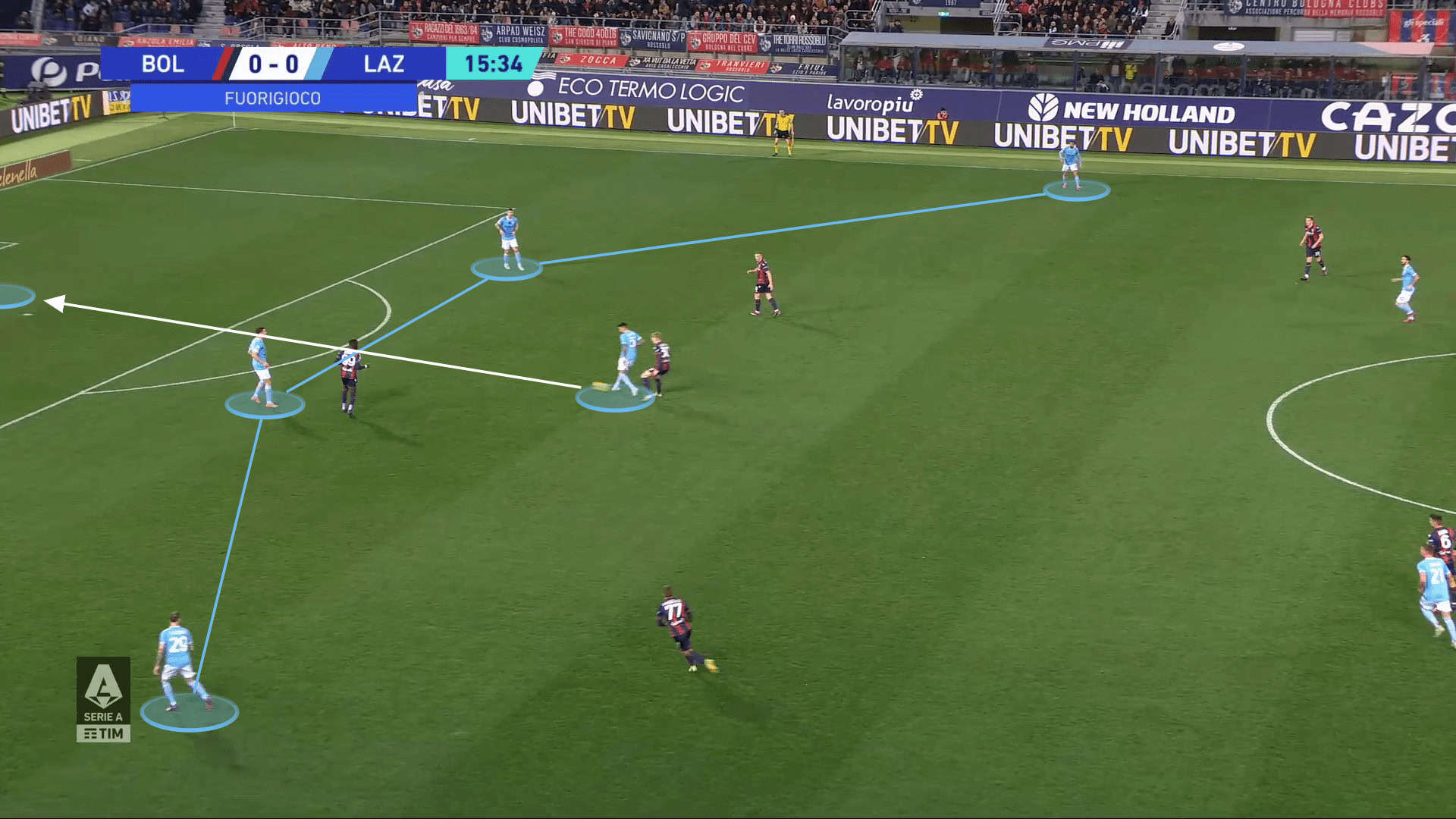
Maurizio Sarri likes his teams to build out from the back through the goalkeeper and slowly play through the thirds as the team moves up the pitch. They keep a 4-1 build-up when the ball is in their third. This is to maintain security on the ball in what would be a dangerous area to lose the ball. The ball is moving along the back line, with the holding midfielder giving depth to the build-up, otherwise, it would be too predictable.
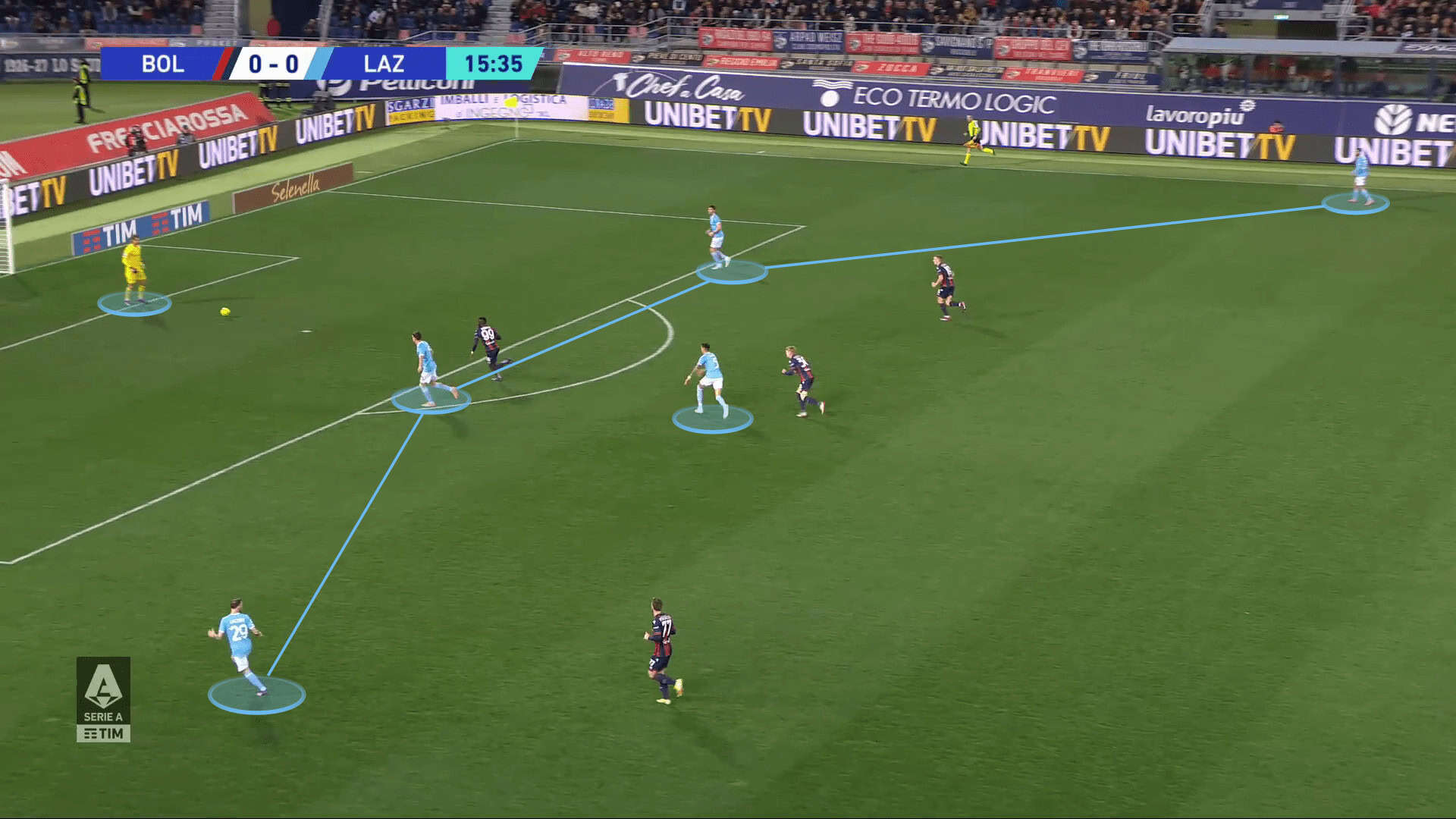
In goal-kick situations, one of the central defenders will pass the ball to the goalkeeper. This allows the ball to be in a central area so teams can’t force Lazio to go one way and box them in.
During the build-up, Lazio aim to escape the press by progressing it in wide areas. The goalkeeper usually waits to attract pressure before playing a lofted pass over the top to a fullback. In those wide areas is where Lazio show creativity in playing through the press with his ingenuity.
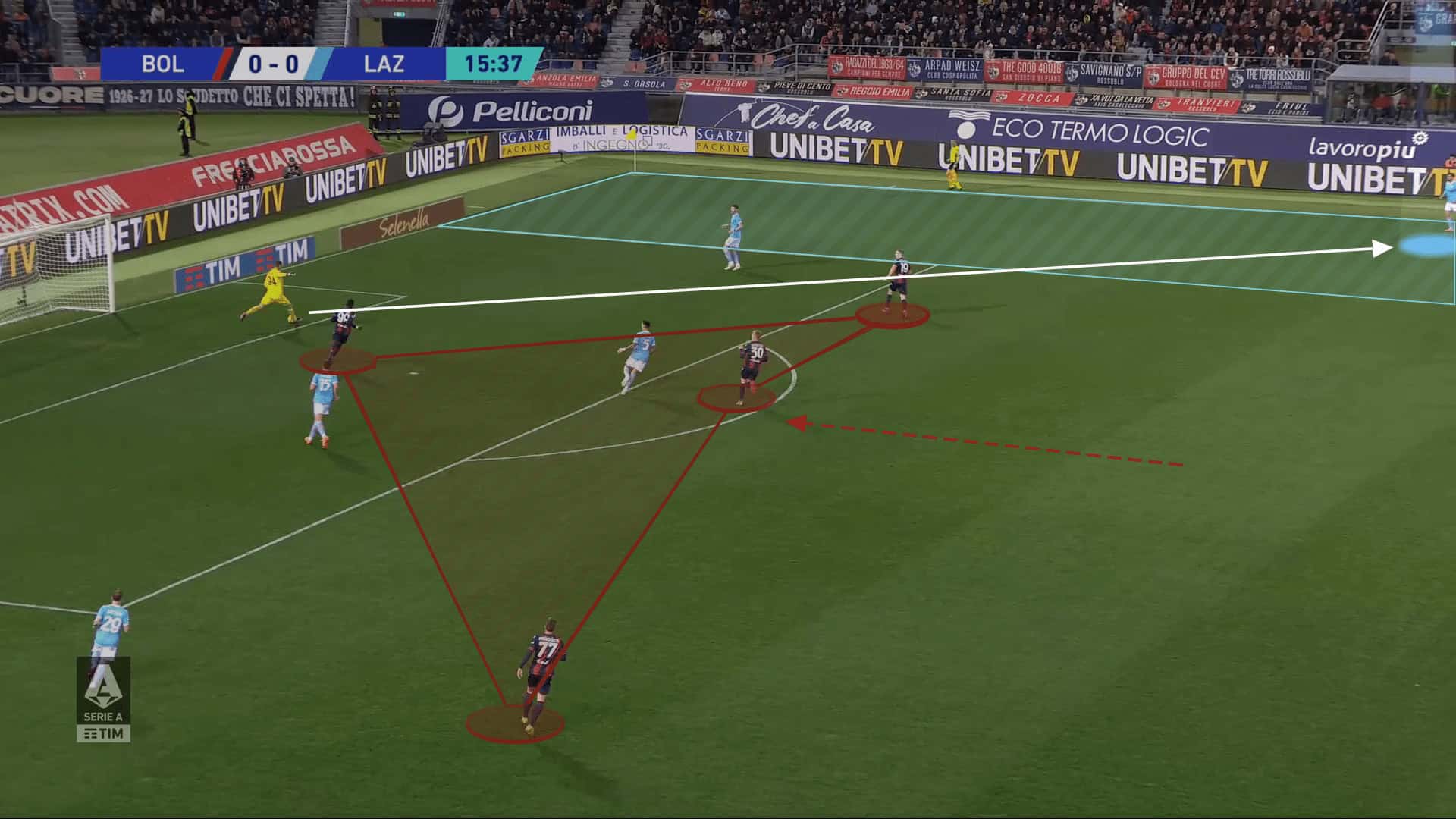
Sarri has also worked on creating 3v2s in wide areas where the fullback, winger and central midfielder can combine to progress the ball thanks to numerical superiority. Working in wide areas is something Sarri prioritises, as opposition players have a dilemma as to whether they should press the ball, and vacate open spaces in the middle of the pitch, or simply let the Lazio players have the ball in a less dangerous position.
When passing the ball into the opponent’s half, he uses the risky option of stretching the game very wide, trying to create as much space as possible in the centre and direct the ball there with the intention of entering the offensive third. Sarri also uses a similar variant near the rival’s penalty area. They stretch the game wide again, freeing up space in the centre of the pitch, which not only creates space for the players entering there but also allows for a combination passing game.
Lazio’s players turn their lack of speed in attack into an attempt to penetrate the defence with a number of combination actions and if that fails, they use more direct attempts to cross to the strikers in the penalty area.
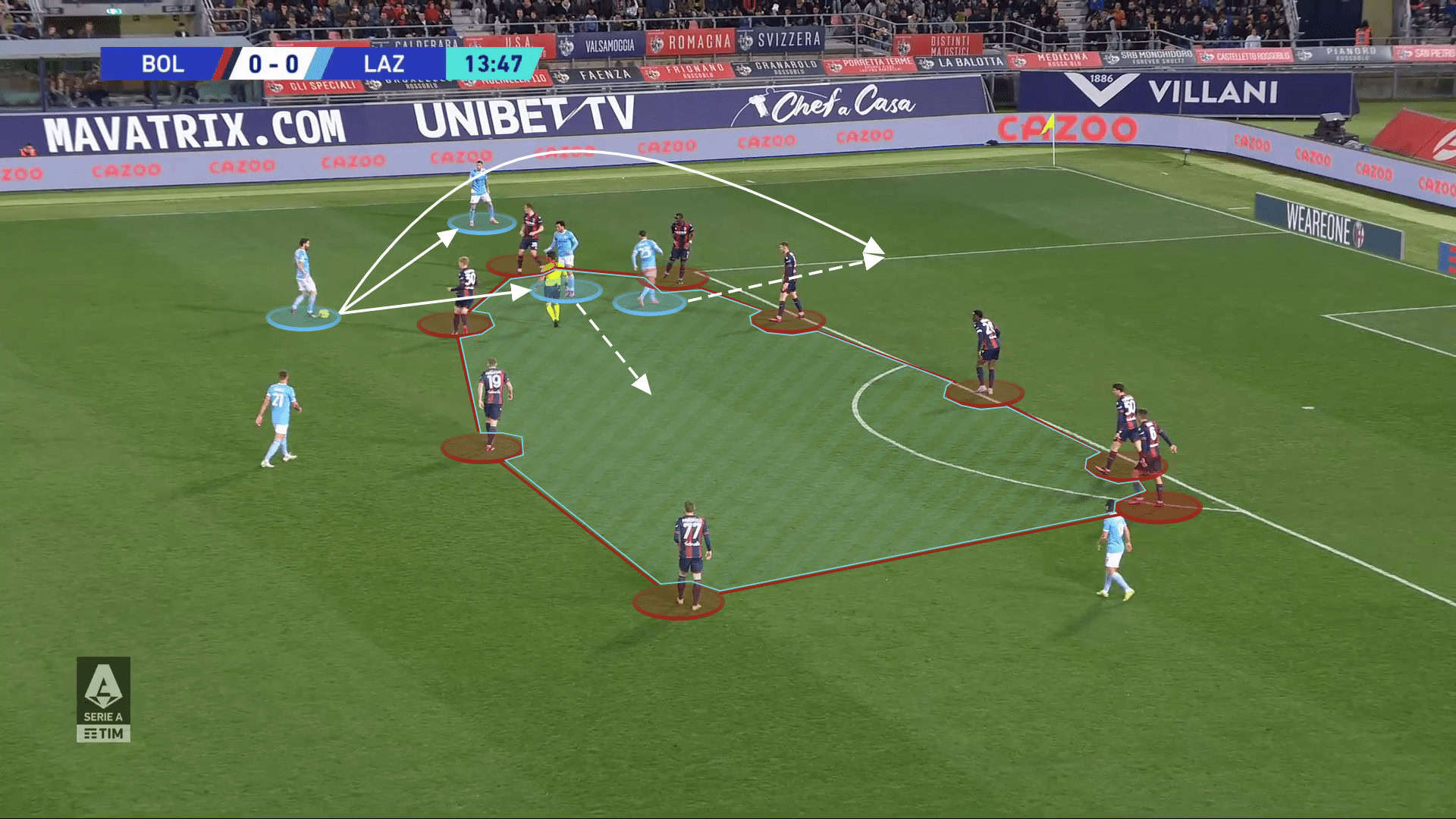
This is something Roma could struggle with. The contrast in shapes might set the match up to be an open end-to-end affair. Both teams will be seeking to generate chances by using the width their shapes lend themselves to. Roma too often are caught with their wingbacks high up the pitch leaving the three in the back vulnerable to equal, or odd-man rush counter-attacking scenarios.
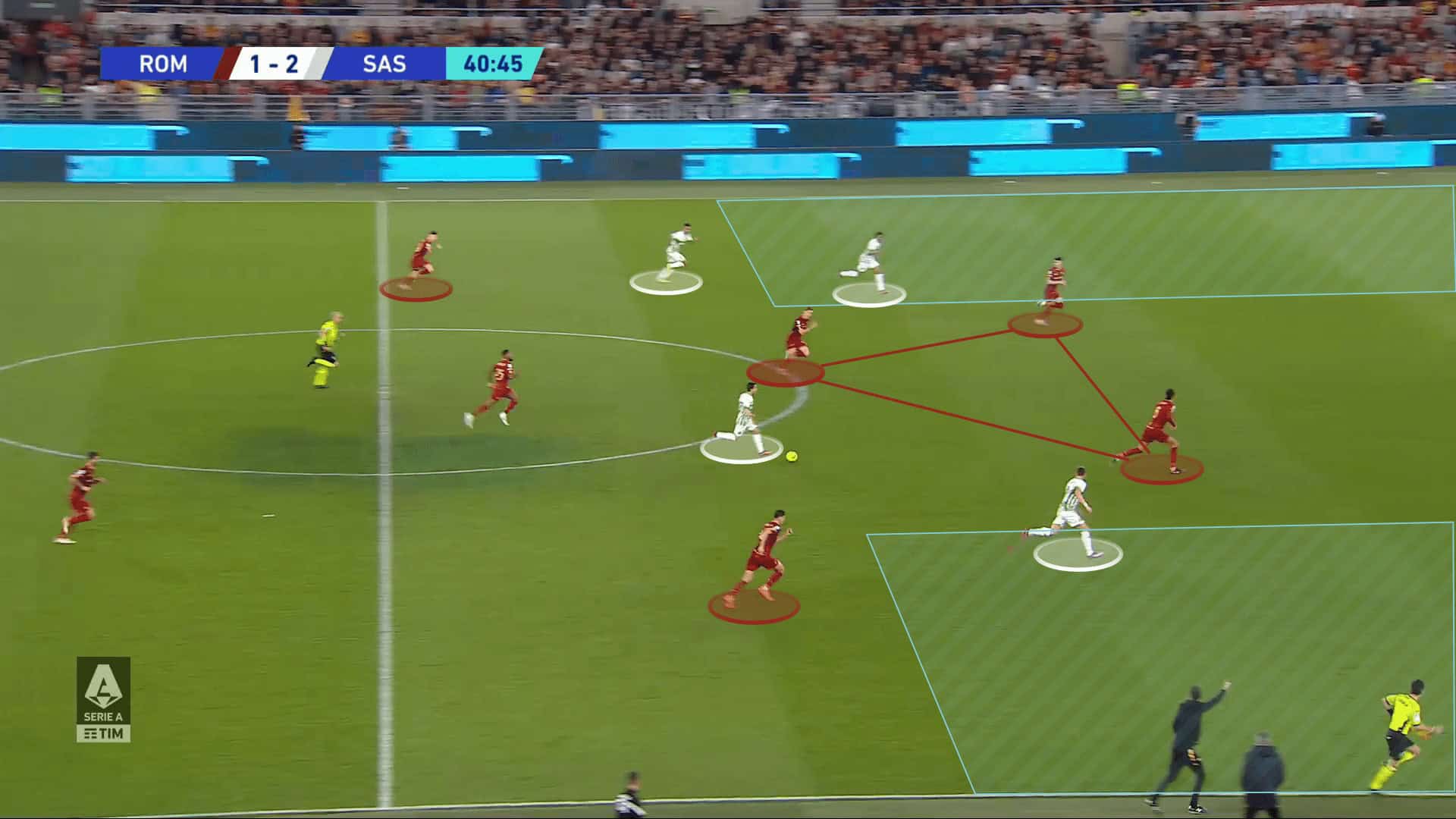
Another key method Lazio use to penetrate the box is through reverse passes into those similar areas next to the byline. The image below shows how Milinkovic-Savic opens up his body, making it seem as if he is looking to switch the ball. This makes the defenders shuffle, and while they move one way, Milinkovic-Savic passes the ball in the space the defenders just vacated, with a run into that space planned out by Sarri.
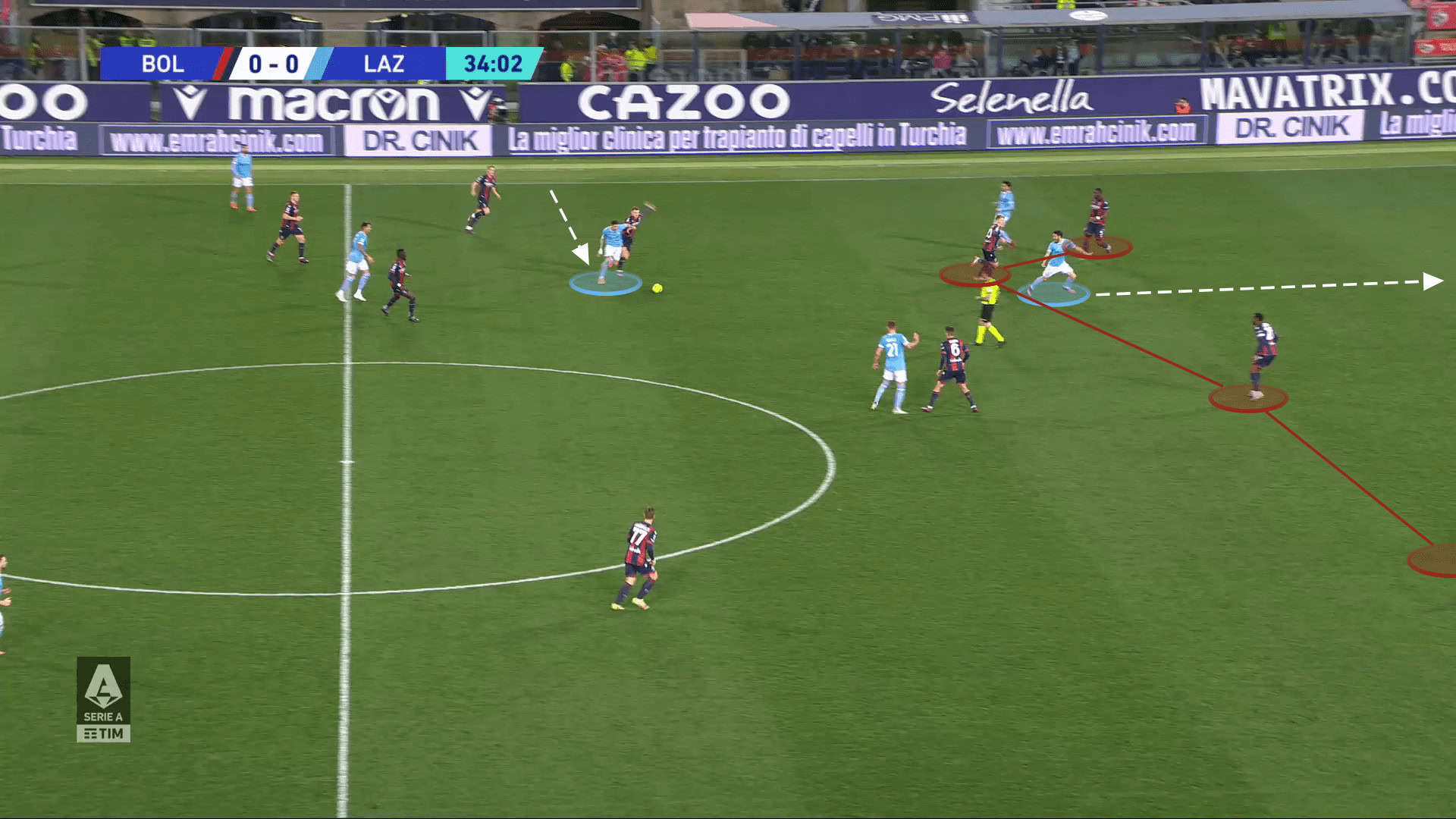
Roma’s weapon against Lazio’s compactness
In defence, they generally press high by adopting a 4-5-1 shape which allows them to provide good security on the wings but causes a lack of compactness in the centre. Lazio attempt to press opposition teams high regularly, however, they usually are most successful when doing so in dead ball situations. When there is a goal kick or throw-in, the Lazio players have the time to get close to their opposition and prevent them from playing out the back.
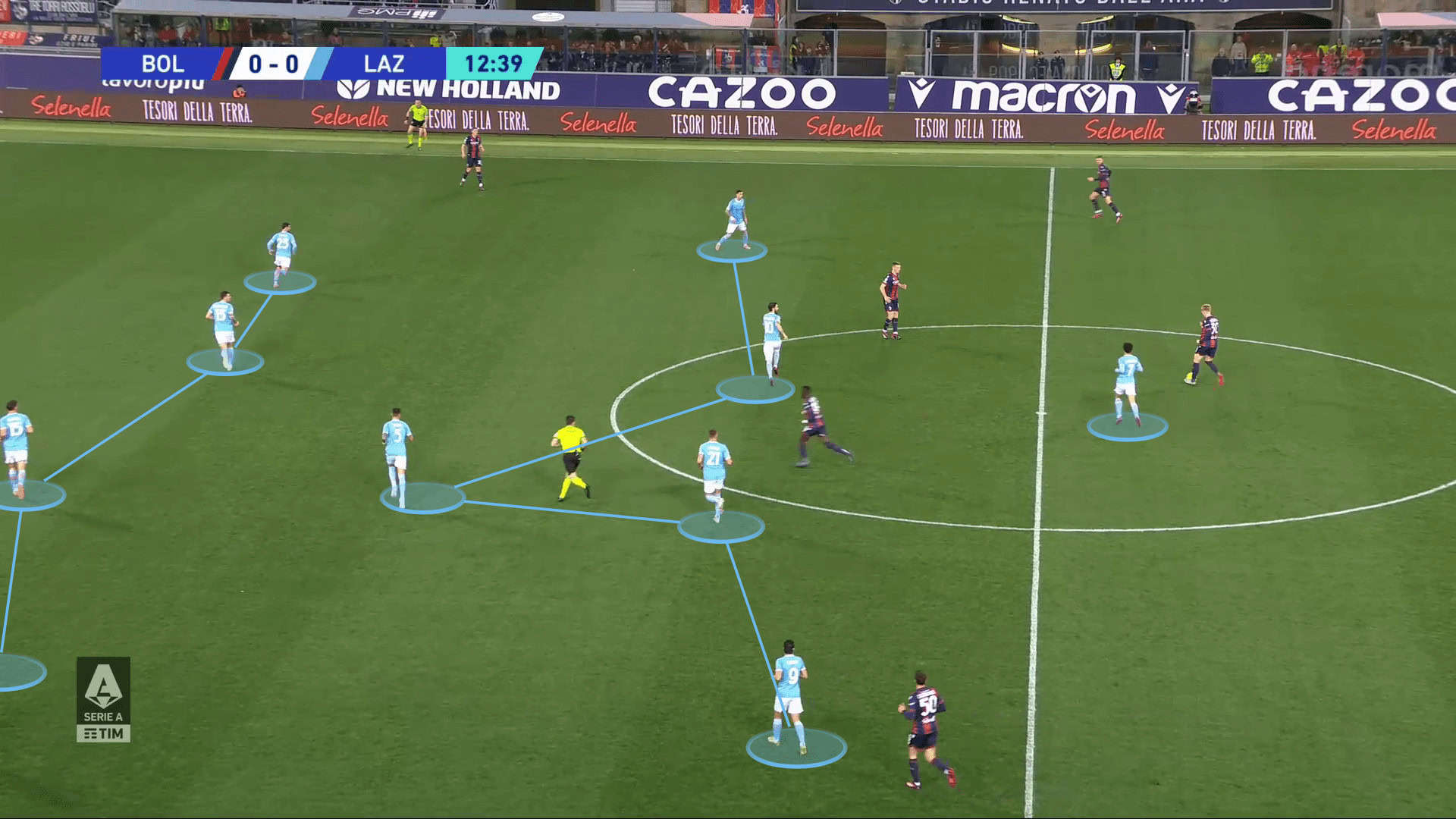
When the ball is in open play, Lazio struggle to implement their press and this is where the chaos comes in. Starting in a 4-5-1 shape, Sarri instructs his central midfielders to initiate the press. This causes many problems for the Lazio players. While the wide players ensure the ball doesn’t progress in wide areas, the press from a central midfielder leaves spaces between midfielders and wide players heavily exposed.
Due to the midfielder having to cover a big amount of distance to press the ball, the defenders on the ball have plenty of time to play their pass. By the time the midfielder presses the centre back, the ball is already with another player and the other Lazio players have to scramble to cover the spaces. This leaves a 3v1 in those wide areas where it is very easy for Roma to progress the ball and launch an attack.
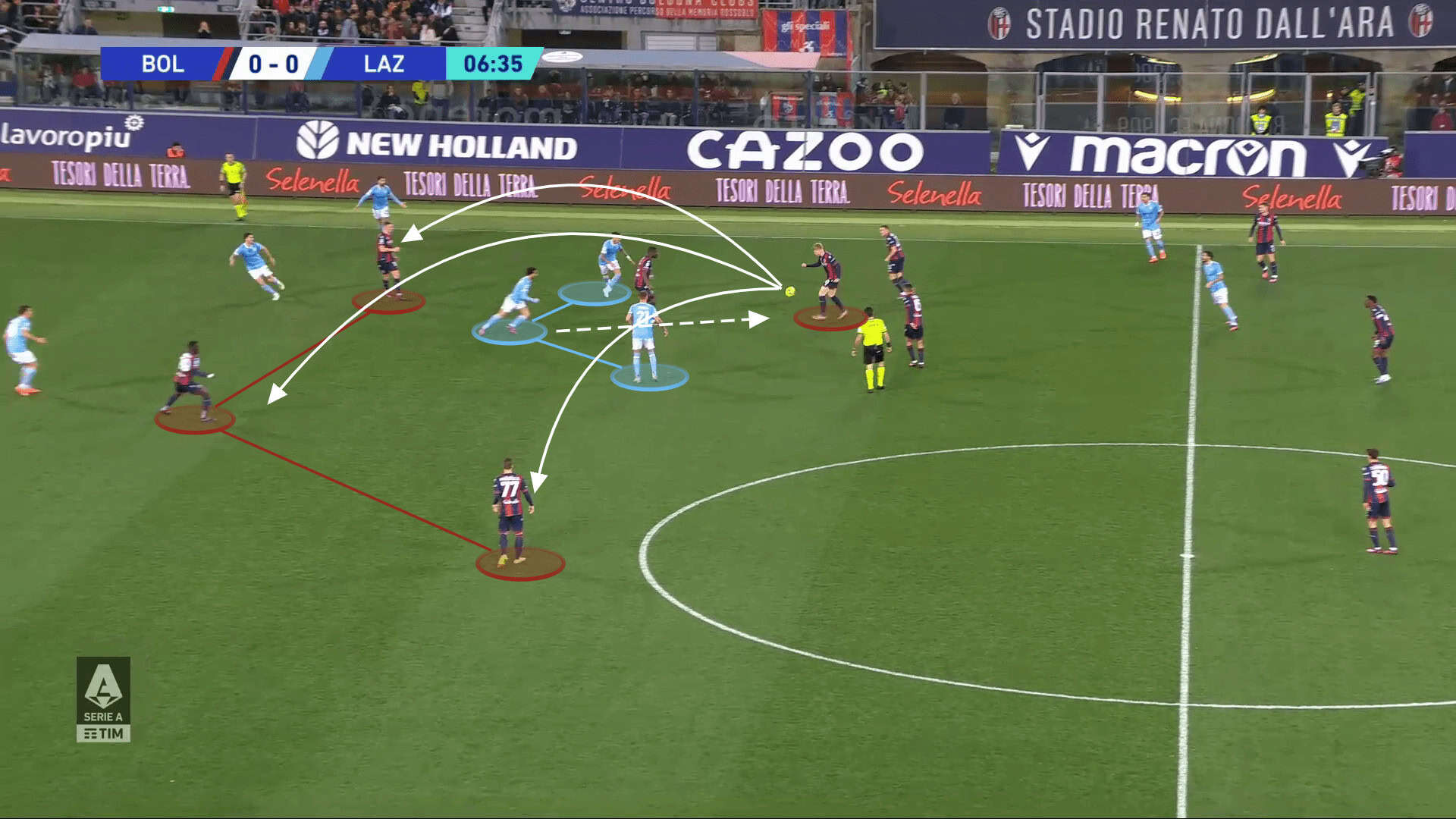
If Lazio fail to pick up the ball quickly, they retreat into their own half allowing their rivals to play the ball around. The proximity of the two lines of pressure ensures that they have no space for the rival to force the action through the centre. After all, this defensive scheme is prone to individual positioning mistakes, which generally result in gaps and a lack of cover in the zones left by individual player’s movements.
Lazio are tough to break down when they do sit in their 4-5-1 mid-block and allow the opposition to have time on the ball. Although this may not be what Sarri wants, as he wants to dominate possession, it is smarter to let the opposition have lots of touches of the ball in their own half, rather than having few touches in extremely dangerous areas. Whilst Lazio do well in deeper areas when they allow the opposition to have the ball, their players do tend to get impatient and repeatedly jump out of position.
The formation of Roma is very efficient. When Roma struggle to generate offence through the middle channels, they often shift the ball wide to allow ample crosses to flood the box, making use of their aerial advantage, and tall targets to aim for. Resulting from having two wingbacks committed high up the pitch, Roma can recycle any crosses that go deep back into dangerous areas.
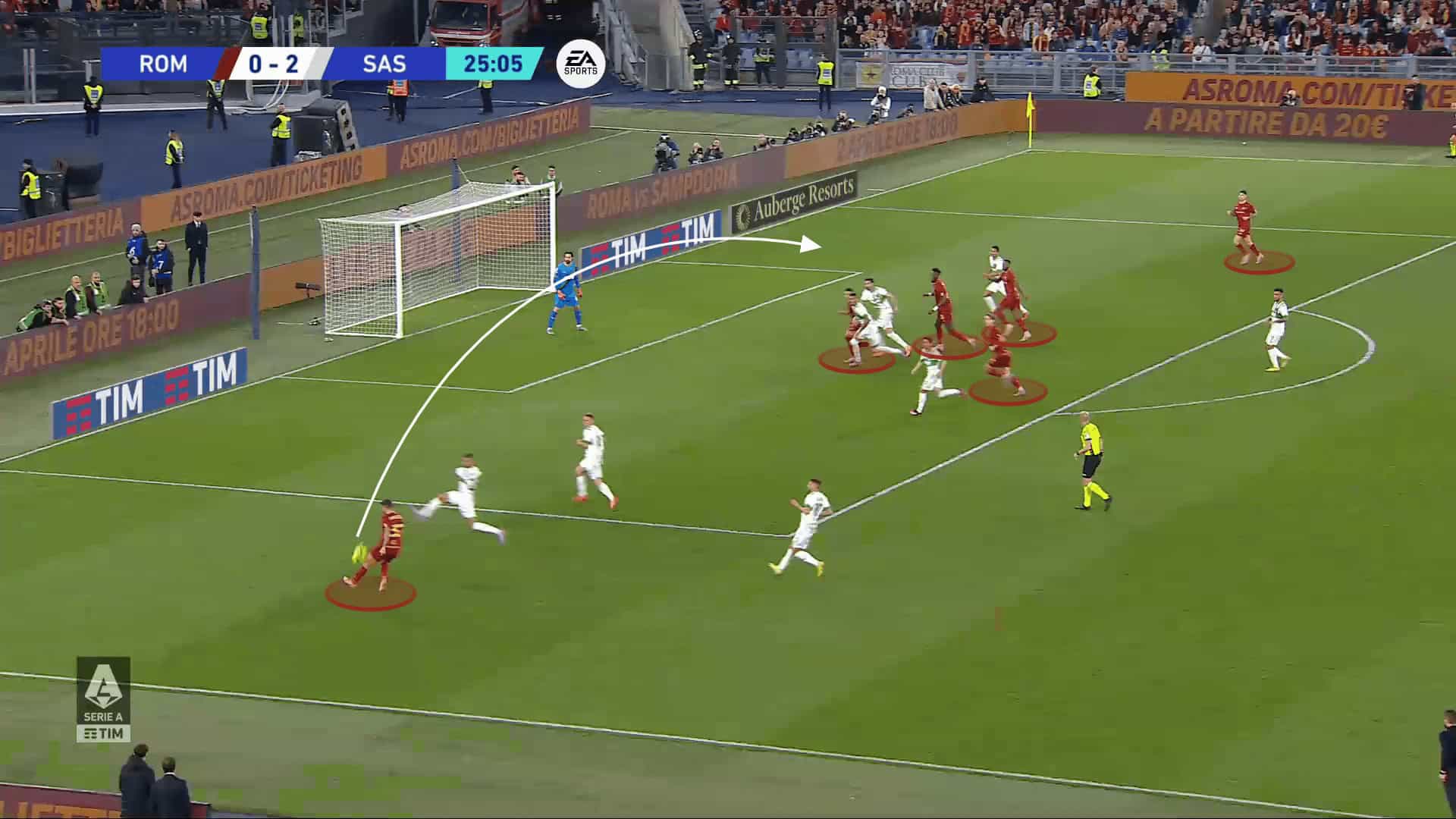
But sometimes, their game becomes one-dimensional and they begin to rue missing chances early. This might happen, especially when Lazio get comfortable in a low defensive block only looking to counter.
Therefore, Paulo Dybala will be the key player in Roma’s game once again. The Argentinian playmaker always tries to find solutions in the central areas of the pitch. His intelligence in combination with the impatience of Lazio’s players might open up passing lines that lead to goal-scoring opportunities. The introduction of Dybala against Sassuolo showed his brilliance again. He gave the team that central link-up play which resulted in an extremely well-taken goal.
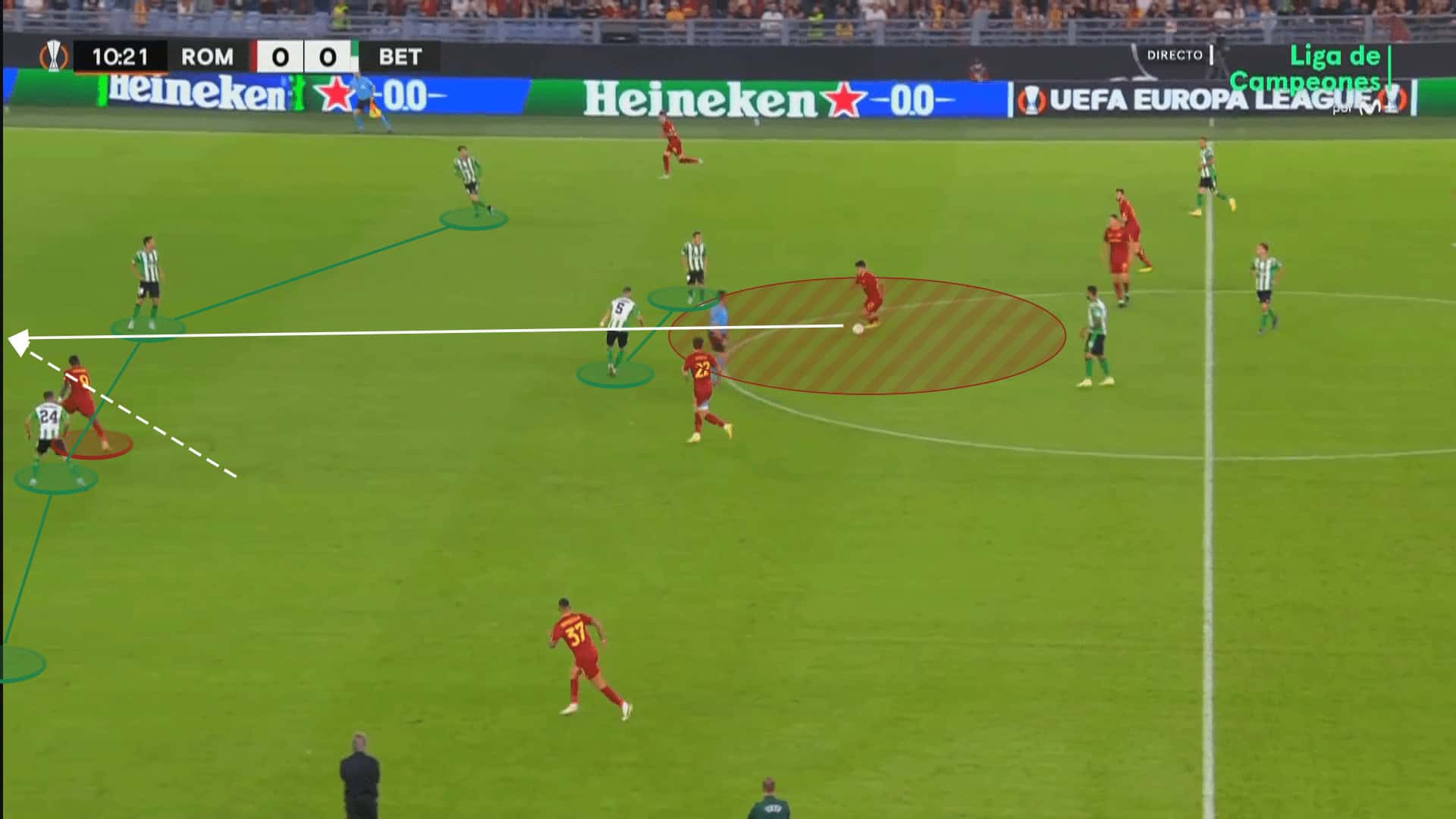
Conclusion
Both teams will focus on staying compact in defence. Since it is a derby, we probably won’t see a boring and solely defensive-focused match. The contrast in the formations of both teams might lead to some dangerous counter-attacking situations. Lazio might use the space on the wing in attack since Roma’s wing-backs are used to push high. Roma’s formation let them take advantage of the whole width in attack and with Paulo Dybala, they have a playmaker who can break lines in central areas of the pitch.
It will be a tight match which is likely to end in a draw, although individual errors could make the difference in this interesting match with both teams fighting for the Champions League places in Serie A.





Comments